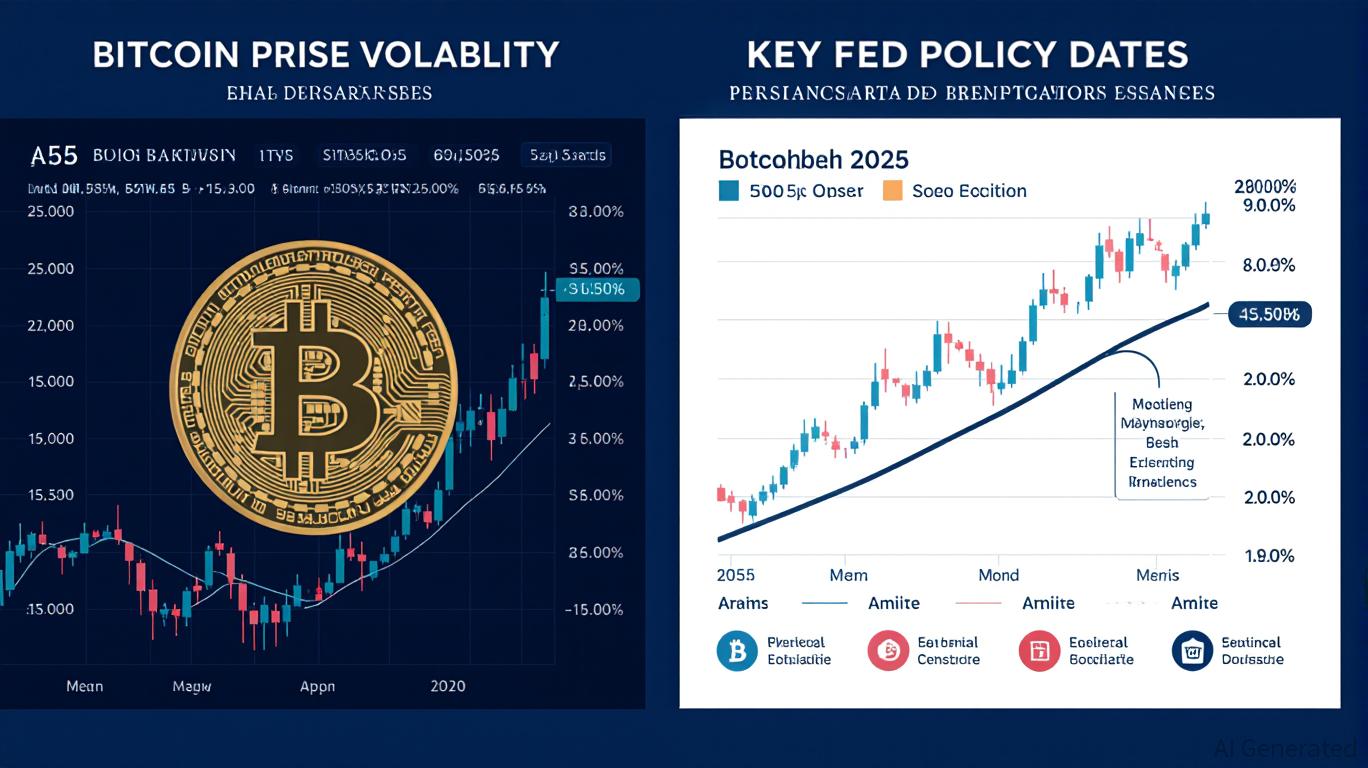Bitcoin Experiences Abrupt Price Swings as Global Economic Conditions Change: The Impact of Federal Reserve Actions and Regulatory Ambiguity on Cryptocurrency Values
- Bitcoin's 2025 volatility reflects Fed policy shifts and regulatory uncertainty, with price surging 86.76% amid rate cuts but sliding below $107,000 due to central bank ambiguity. - Regulatory developments like spot ETF approvals injected $4.21B in October, yet SEC delays and mixed global frameworks (e.g., EU MiCA vs. China's stability focus) create fragmented investor sentiment. - Institutional adoption grows (e.g., SoFi's crypto trading launch), but structural challenges persist, including miner losses
Fed Policy: Bitcoin’s Volatility Engine
The Federal Reserve’s approach in 2025 has been a central factor in Bitcoin’s price swings. At the start of the year, tight monetary policy—characterized by persistently high interest rates and a cautious outlook from Chair Jerome Powell—put downward pressure on riskier assets, including
Nonetheless, ongoing ambiguity from the Fed has created obstacles. Powell’s emphasis on “strongly differing views” regarding future rate reductions has left markets uncertain, with Bitcoin dropping below $107,000 in late October despite the start of rate cuts, according to
Regulatory Flux: Fuel for Growth and Instability
Shifts in regulation throughout 2025 have further intensified Bitcoin’s price fluctuations. The greenlighting of spot Bitcoin ETFs, for example, brought in $4.21 billion in new investments in October alone, pushing
At the same time, regulatory advancements in the U.S. have broadened access to Bitcoin. SoFi’s introduction of spot crypto trading in November 2025 was a landmark, enabling users to buy and sell Bitcoin and
Globally, the regulatory environment is fragmented. The EU’s Markets in Crypto-Assets (MiCA) regulation is nearing rollout, while China’s 2025 monetary policy continues to prioritize economic stability over crypto-specific changes, according to Gate. This divergence results in a complex regulatory landscape that complicates global investor confidence.

Macroeconomic and Regulatory Forces: At a Crossroads?
By the end of 2025, Bitcoin’s value is closely tied to the interplay between economic easing and regulatory transparency. ETF inflows have provided crucial support, but their impact depends on whether daily purchases surpass 2,500 BTC—a level associated with previous surges, according to Gate. On the other hand, structural issues remain: mining companies such as Bitdeer Technology Group, which posted a $266.7 million net loss in Q3 2025, illustrate the industry’s fragility amid higher costs and reduced rewards after the halving, as Gate notes.
Analysts believe Bitcoin’s next direction will be shaped by how these elements interact. If the Fed continues to focus on controlling inflation at the expense of growth, crypto demand could weaken. Conversely, regulatory alignment—such as the SEC’s efforts to clarify investment contract rules—could help steady investor sentiment, according to Gate. Additionally, Bitcoin’s price remains closely linked to broader economic indicators, such as the October inflation data, as Gate highlights.
Conclusion: Adapting to a New Era of Volatility
The turbulence seen in Bitcoin’s price throughout 2025 reflects its evolution from a speculative instrument to one increasingly influenced by macroeconomic trends. While central bank policy and regulatory changes are still key drivers, the crypto sector’s growing maturity—demonstrated by ETF launches and institutional participation—suggests that Bitcoin’s value may become less reactive to short-term disruptions in the future. For now, though, investors must contend with a market where every policy decision, regulatory announcement, and economic report can dramatically alter Bitcoin’s course.
Disclaimer: The content of this article solely reflects the author's opinion and does not represent the platform in any capacity. This article is not intended to serve as a reference for making investment decisions.
You may also like
Polkadot News Today: "Why Presale Investors Prefer BlockchainFX's AOFA License Instead of Polkadot or Polygon"
- BlockchainFX secures AOFA license, boosting investor confidence and attracting whale capital amid market shifts toward early-stage projects. - Its $11M+ presale offers tokens at $0.03 with a 50% bonus code, contrasting with slower growth curves of Polkadot and Polygon due to larger market caps. - The project's hybrid model combines regulatory credibility, utility-driven beta platform, and staking rewards, positioning it as a "super app" for multi-asset trading. - Aggressive ROI projections and $500K Glea

BCH Stock - 0.70% Potential Gain as Governance Improves
- BCH fell 0.02% in 24 hours and 5.51% monthly, with Goldman Sachs maintaining a Neutral rating and 0.70% upside target. - Institutional holdings showed mixed activity, including a 289.93% stake reduction by Baillie Gifford, while governance reforms aimed to enhance transparency. - Projected 19.4% revenue growth and $8.49 non-GAAP EPS signal modest recovery, though weak loan growth and bearish put/call ratio (4.11) highlight risks.
Ethereum Updates Today: Fluctuations in Ethereum Highlight Institutional Trust in Core Financial Infrastructure
- Joseph Chalom, ex-BlackRock digital assets head, positions Ethereum as the trusted infrastructure for institutional finance due to its stablecoin dominance, tokenization capabilities, and smart contract ecosystem. - Major firms like BlackRock and Fidelity leverage Ethereum for tokenized funds, while projects like Securitize advance asset tokenization, with Sharplink staking $3B ETH to generate 3% annual yields. - Despite Ethereum's recent price volatility (trading at $3,421 as of Nov 11, 2025), instituti
Bitcoin Updates: The $1.2 Million Bitcoin Buzz Versus Broader Economic Facts – Which Side Holds True?
- Peter Schiff dismisses Cathie Wood's $1.2M Bitcoin 2030 target as speculative, arguing macroeconomic fundamentals don't justify such valuations. - Wood attributes her bullish stance to institutional adoption and macro tailwinds, reflected in ARK's strategic investments in disruptive tech. - Market data shows Bitcoin's volatility amid whale offloading, ETF outflows, and mixed institutional positioning, signaling ongoing bearish-bullish tug-of-war. - Stablecoin growth to $4T by 2035 raises regulatory conce
